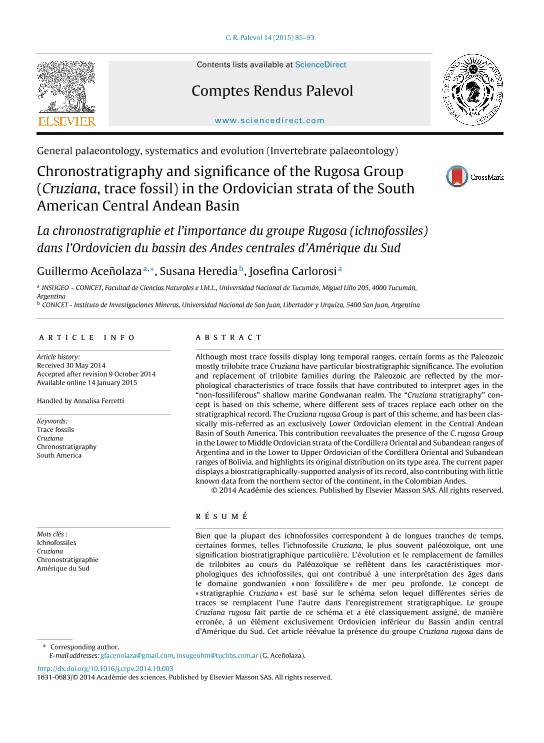Mostrar el registro sencillo del ítem
dc.contributor.author
Aceñolaza, Guillermo Federico

dc.contributor.author
Heredia, Susana Emma

dc.contributor.author
Carlorosi, Josefina María Teresa

dc.date.available
2021-05-06T19:43:42Z
dc.date.issued
2015-02
dc.identifier.citation
Aceñolaza, Guillermo Federico; Heredia, Susana Emma; Carlorosi, Josefina María Teresa; Chronostratigraphy and significance of the Rugosa group (Cruziana, trace fossil) in the Ordovician strata of the South American Central Andean Basin; Elsevier France-editions Scientifiques Medicales Elsevier; Comptes Rendus Palevol; 14; 2; 2-2015; 85-93
dc.identifier.issn
1631-0683
dc.identifier.uri
http://hdl.handle.net/11336/131565
dc.description.abstract
Although most trace fossils display long temporal ranges, certain forms as the Paleozoic mostly trilobite trace Cruziana have particular biostratigraphic significance. The evolution and replacement of trilobite families during the Paleozoic are reflected by the morphological characteristics of trace fossils that have contributed to interpret ages in the “non-fossiliferous” shallow marine Gondwanan realm. The “Cruziana stratigraphy” concept is based on this scheme, where different sets of traces replace each other on the stratigraphical record. The Cruziana rugosa Group is part of this scheme, and has been classically mis-referred as an exclusively Lower Ordovician element in the Central Andean Basin of South America. This contribution reevaluates the presence of the C. rugosa Group in the Lower to Middle Ordovician strata of the Cordillera Oriental and Subandean ranges of Argentina and in the Lower to Upper Ordovician of the Cordillera Oriental and Subandean ranges of Bolivia, and highlights its original distribution on its type area. The current paper displays a biostratigraphically-supported analysis of its record, also contributing with little known data from the northern sector of the continent, in the Colombian Andes.
dc.description.abstract
Bien que la plupart des ichnofossiles correspondent à de longues tranches de temps, certaines formes, telles l’ichnofossile Cruziana, le plus souvent paléozoïque, ont une signification biostratigraphique particulière. L’évolution et le remplacement de familles de trilobites au cours du Paléozoïque se reflètent dans les caractéristiques morphologiques des ichnofossiles, qui ont contribué à une interprétation des âges dans le domaine gondwanien «non fossilifère» de mer peu profonde. Le concept de «stratigraphie Cruziana» est basé sur le schéma selon lequel différentes séries de traces se remplacent l’une l’autre dans l’enregistrement stratigraphique. Le groupe Cruziana rugosa fait partie de ce schéma et a été classiquement assigné, de manière erronée, à un élément exclusivement Ordovicien inférieur du Bassin andin central d’Amérique du Sud. Cet article réévalue la présence du groupe Cruziana rugosa dans de les strates l’Ordovicien inférieur à moyen de la Cordillère orientale et des chaînes subandines d’Argentine et dans les chaînes de la Cordillère orientale et des chaînes sub-andines de Bolivie, en mettant en évidence sa distribution originelle dans cette zone type. L’article fournit une analyse corroborée biostratigraphiquement de son enregistrement et contribue à une meilleure connaissance du secteur nord du continent Sud-Américain, dans les Andes colombiennes.
dc.format
application/pdf
dc.language.iso
eng
dc.publisher
Elsevier France-editions Scientifiques Medicales Elsevier

dc.rights
info:eu-repo/semantics/openAccess
dc.rights.uri
https://creativecommons.org/licenses/by-nc-sa/2.5/ar/
dc.subject
CHRONOSTRATIGRAPHY
dc.subject
CRUZIANA
dc.subject
SOUTH AMERICA
dc.subject
TRACE FOSSILS
dc.subject.classification
Paleontología

dc.subject.classification
Ciencias de la Tierra y relacionadas con el Medio Ambiente

dc.subject.classification
CIENCIAS NATURALES Y EXACTAS

dc.title
Chronostratigraphy and significance of the Rugosa group (Cruziana, trace fossil) in the Ordovician strata of the South American Central Andean Basin
dc.title
La chronostratigraphie et l’importance du groupe Rugosa (ichnofossiles) dans l’Ordovicien du bassin des Andes centrales d’Amérique du Sud
dc.type
info:eu-repo/semantics/article
dc.type
info:ar-repo/semantics/artículo
dc.type
info:eu-repo/semantics/publishedVersion
dc.date.updated
2021-04-28T21:08:22Z
dc.journal.volume
14
dc.journal.number
2
dc.journal.pagination
85-93
dc.journal.pais
Francia

dc.journal.ciudad
París
dc.description.fil
Fil: Aceñolaza, Guillermo Federico. Consejo Nacional de Investigaciones Científicas y Técnicas. Centro Científico Tecnológico Conicet - Tucumán. Instituto Superior de Correlación Geológica. Universidad Nacional de Tucumán. Facultad de Ciencias Naturales e Instituto Miguel Lillo. Departamento de Geología. Cátedra Geología Estructural. Instituto Superior de Correlación Geológica; Argentina
dc.description.fil
Fil: Heredia, Susana Emma. Consejo Nacional de Investigaciones Científicas y Técnicas. Centro Científico Tecnológico Conicet - San Juan; Argentina. Universidad Nacional de San Juan. Facultad de Ingeniería. Instituto de Investigaciones Mineras; Argentina
dc.description.fil
Fil: Carlorosi, Josefina María Teresa. Consejo Nacional de Investigaciones Científicas y Técnicas. Centro Científico Tecnológico Conicet - Tucumán. Instituto Superior de Correlación Geológica. Universidad Nacional de Tucumán. Facultad de Ciencias Naturales e Instituto Miguel Lillo. Departamento de Geología. Cátedra Geología Estructural. Instituto Superior de Correlación Geológica; Argentina
dc.journal.title
Comptes Rendus Palevol

dc.relation.alternativeid
info:eu-repo/semantics/altIdentifier/doi/http://dx.doi.org/10.1016/j.crpv.2014.10.003
dc.relation.alternativeid
info:eu-repo/semantics/altIdentifier/url/https://www.sciencedirect.com/science/article/pii/S1631068314001882
Archivos asociados
